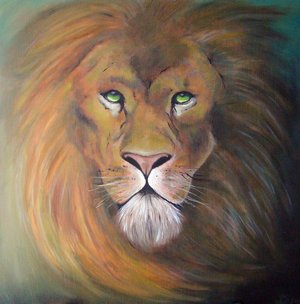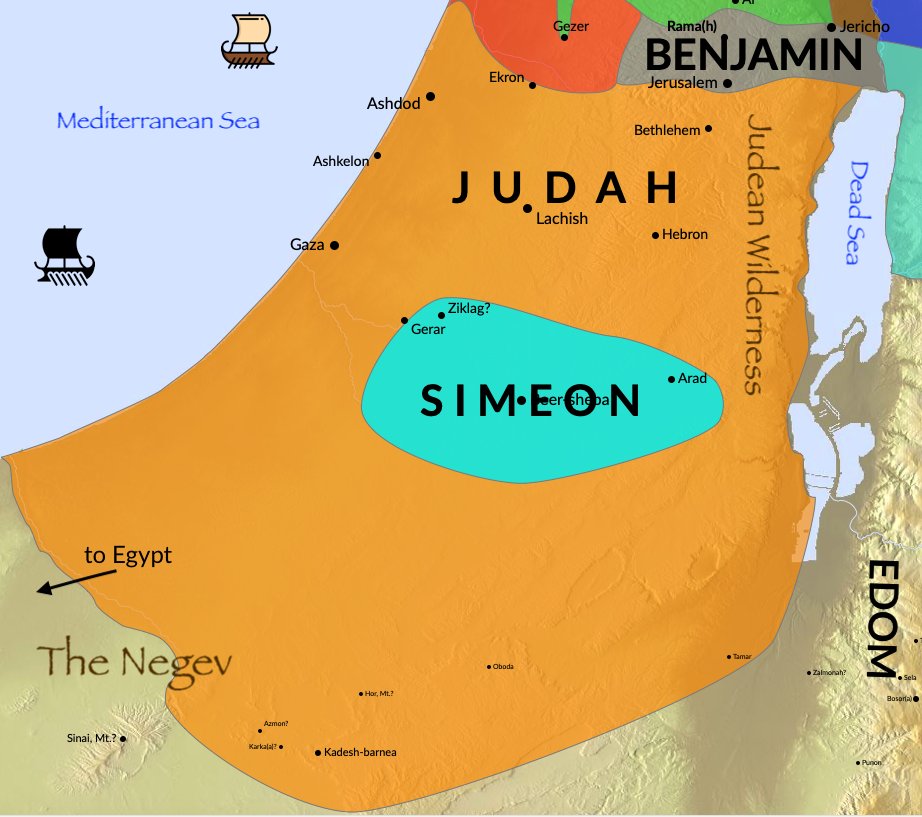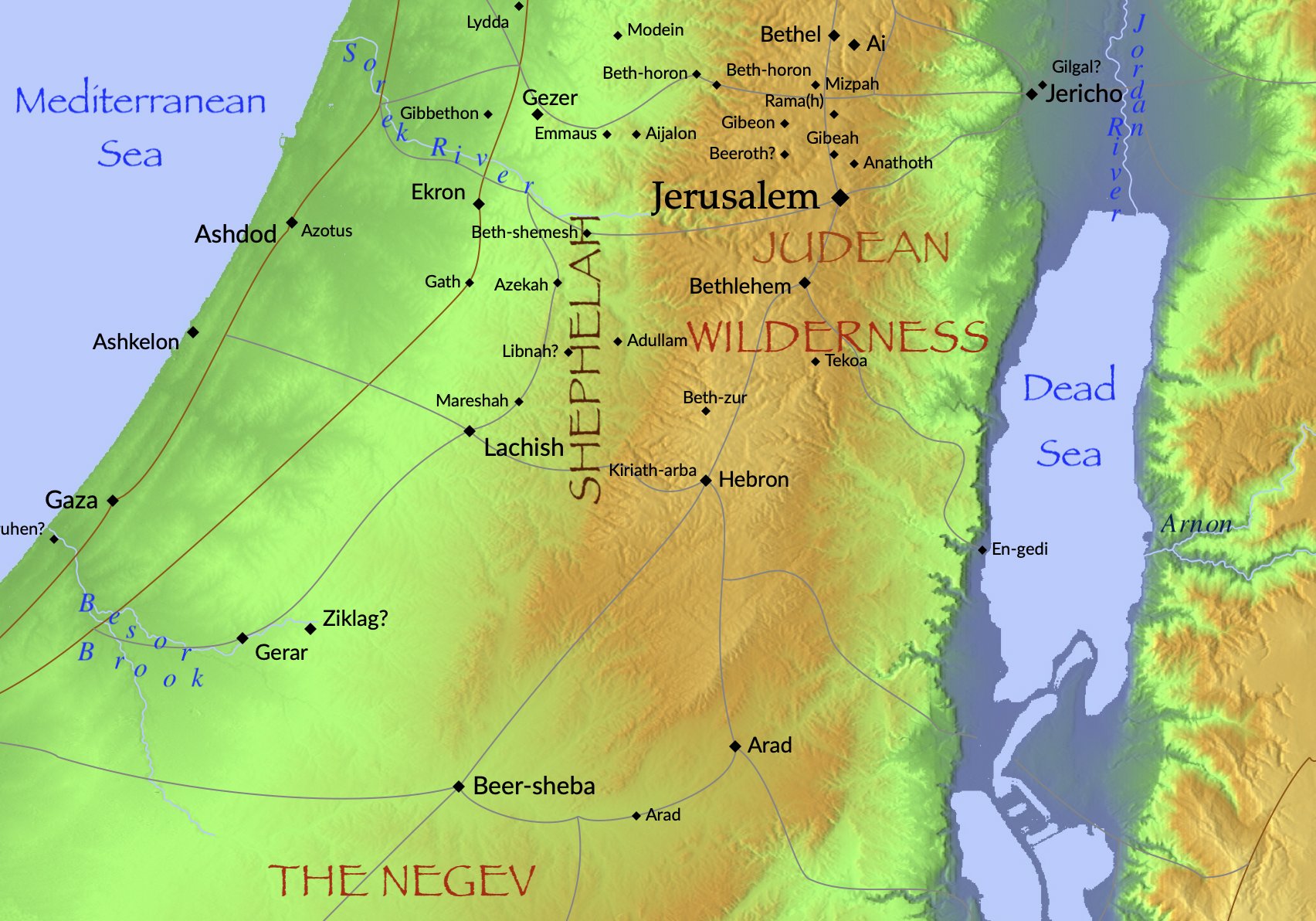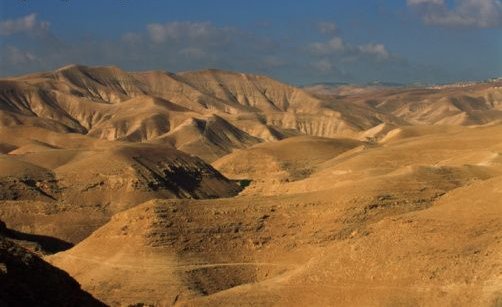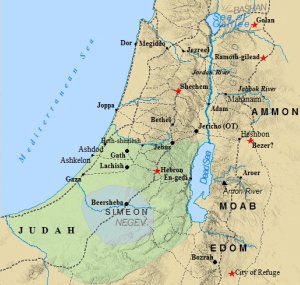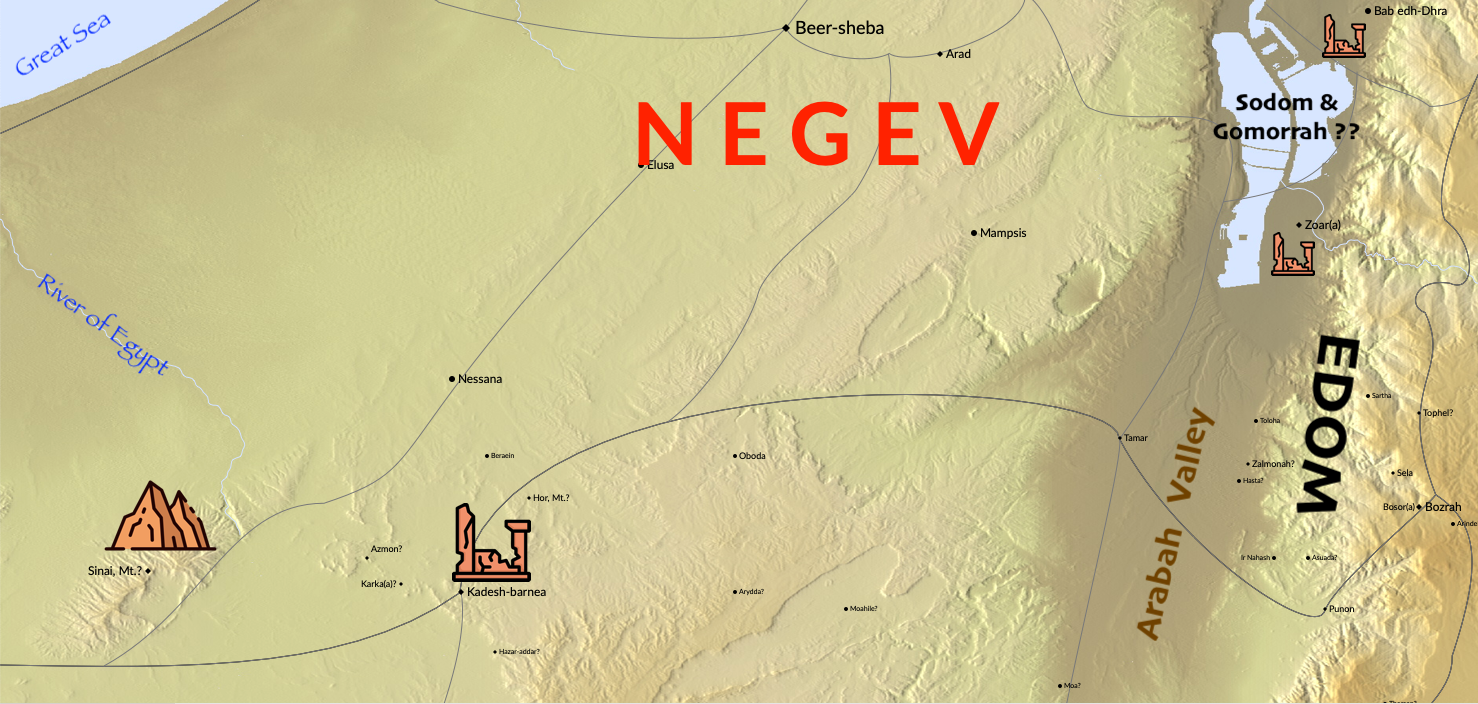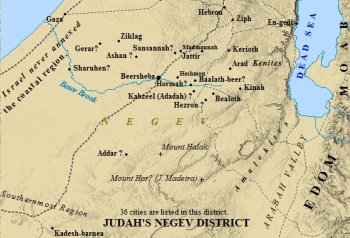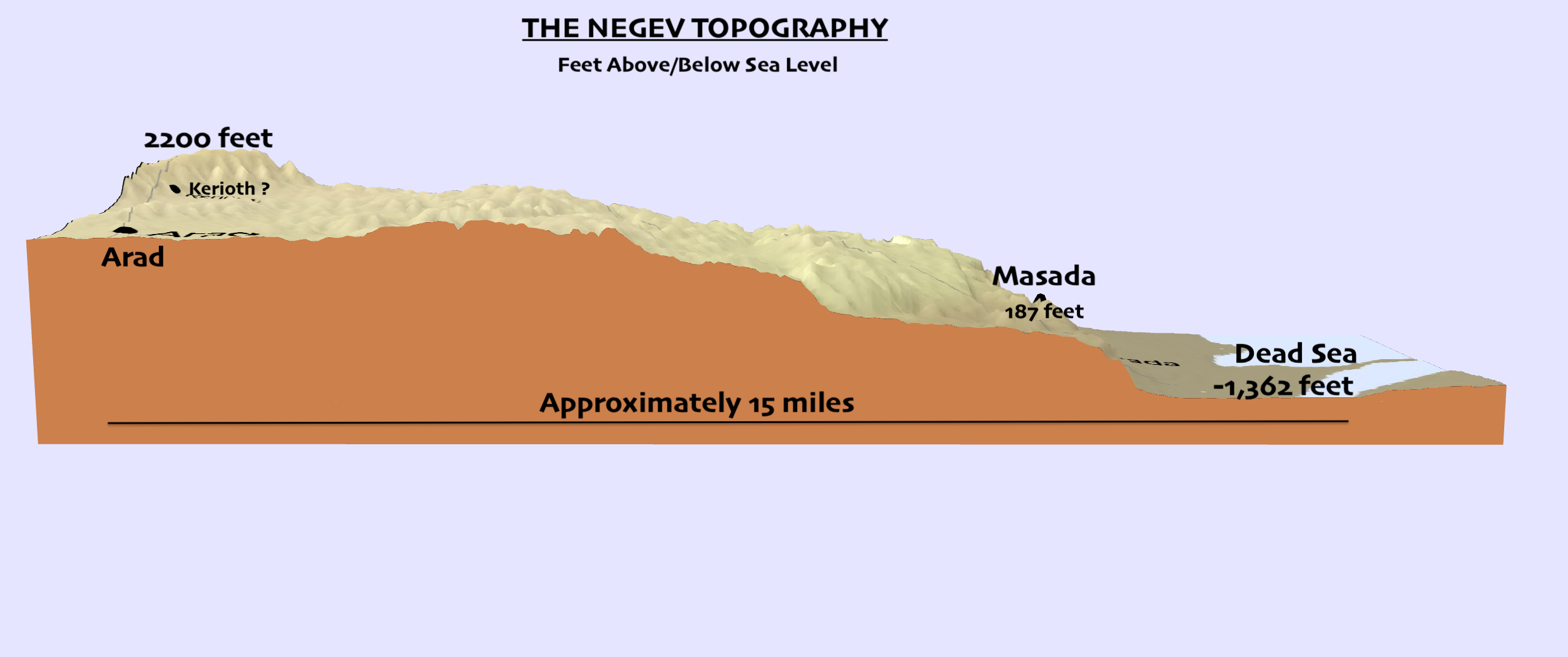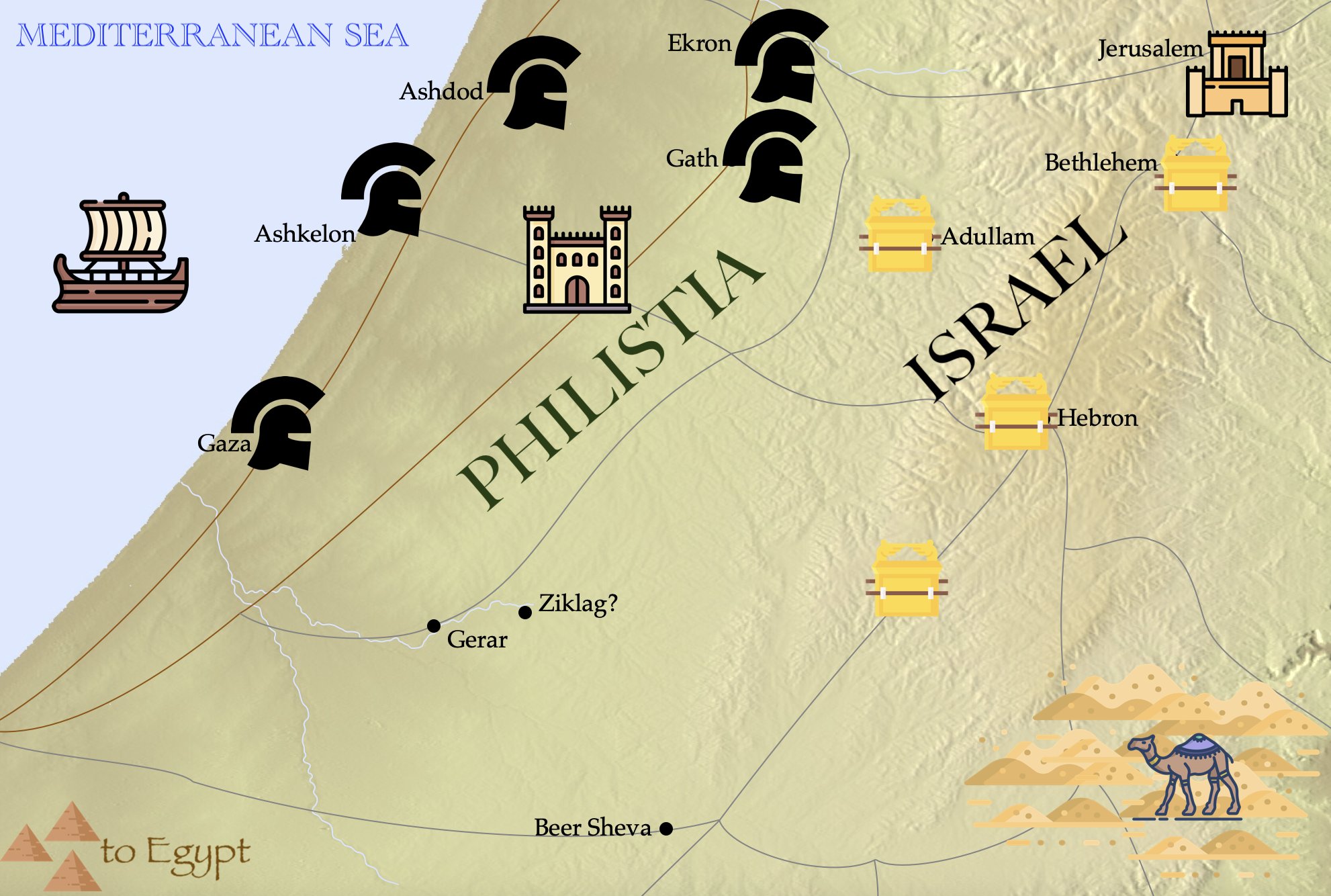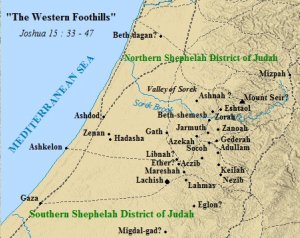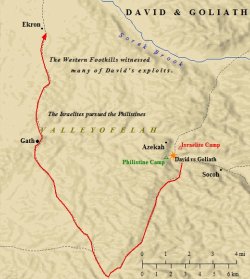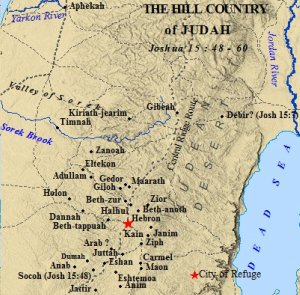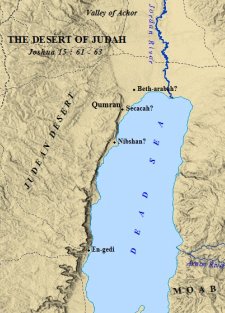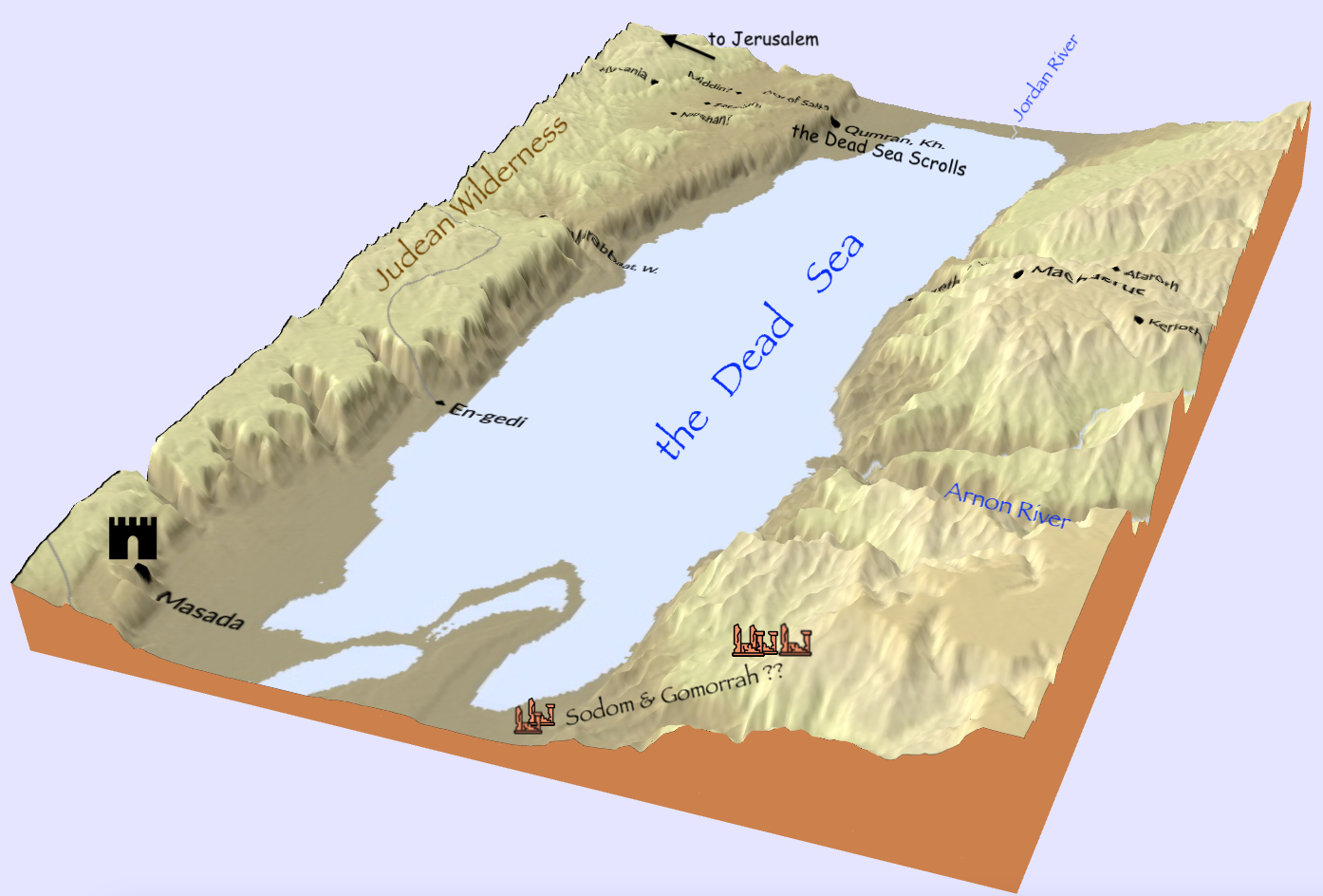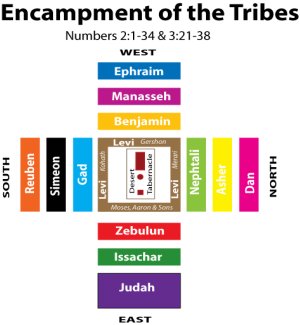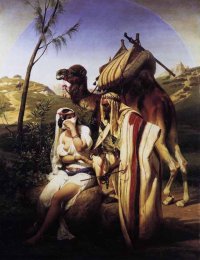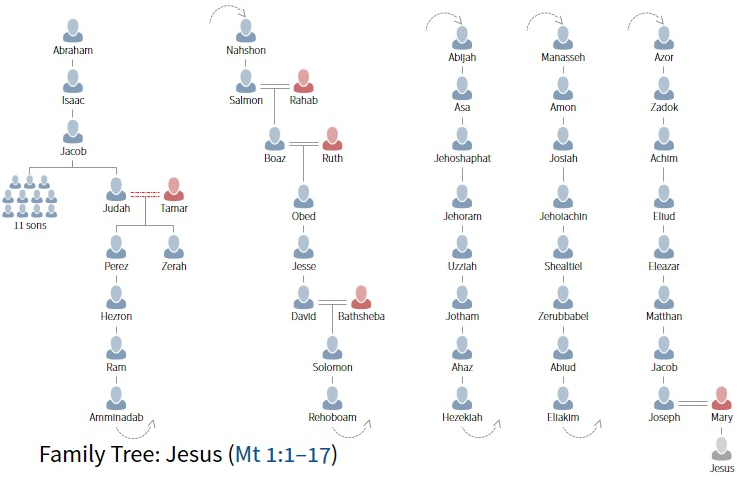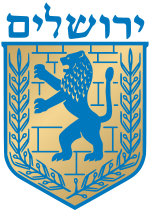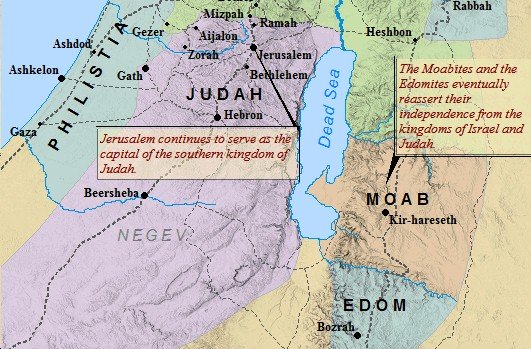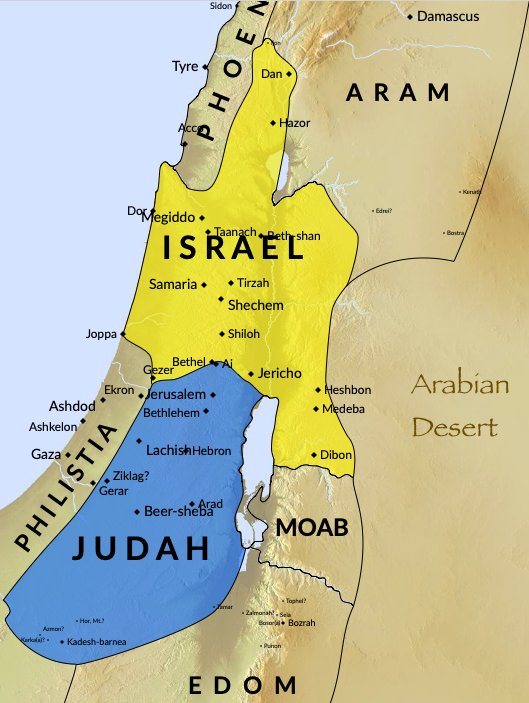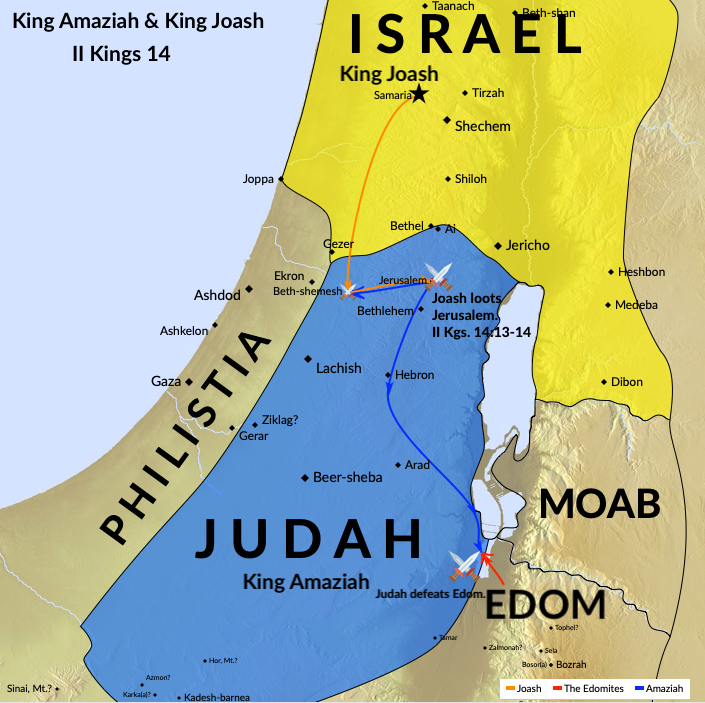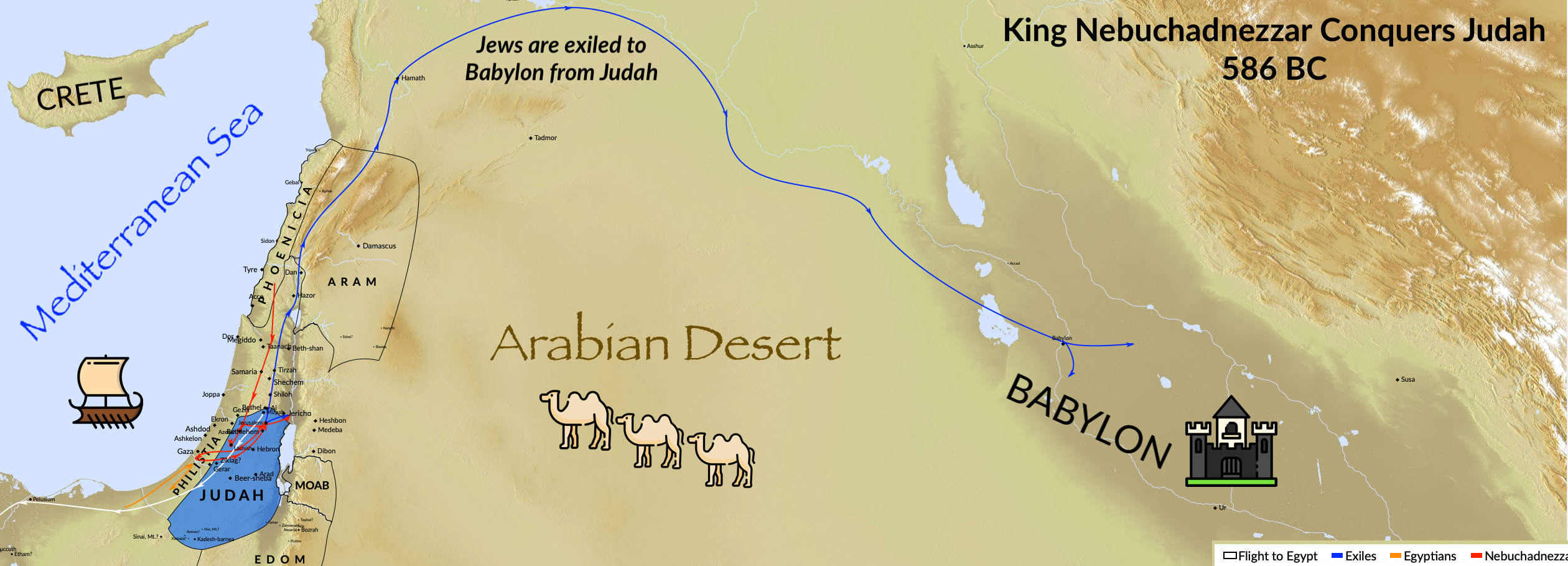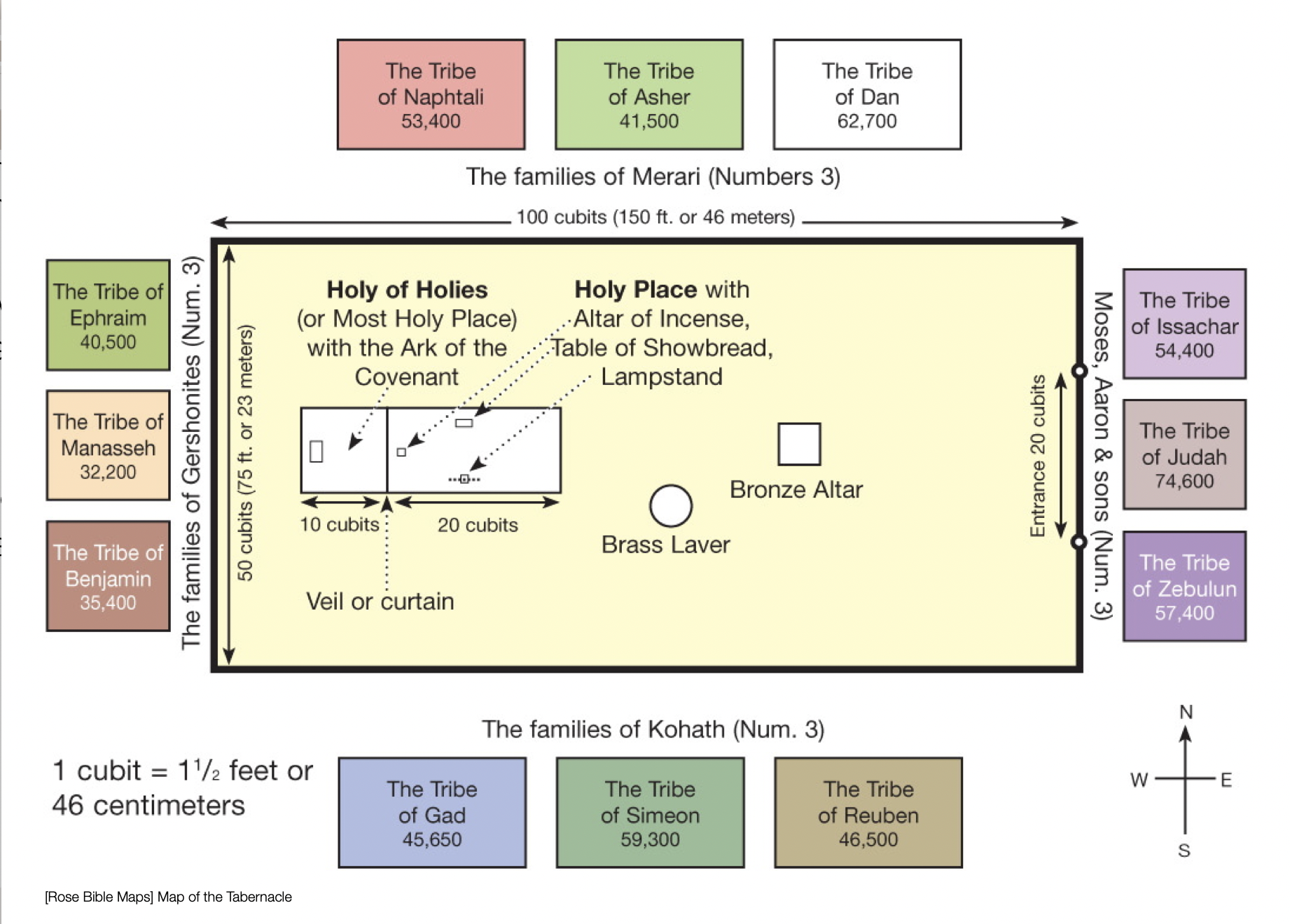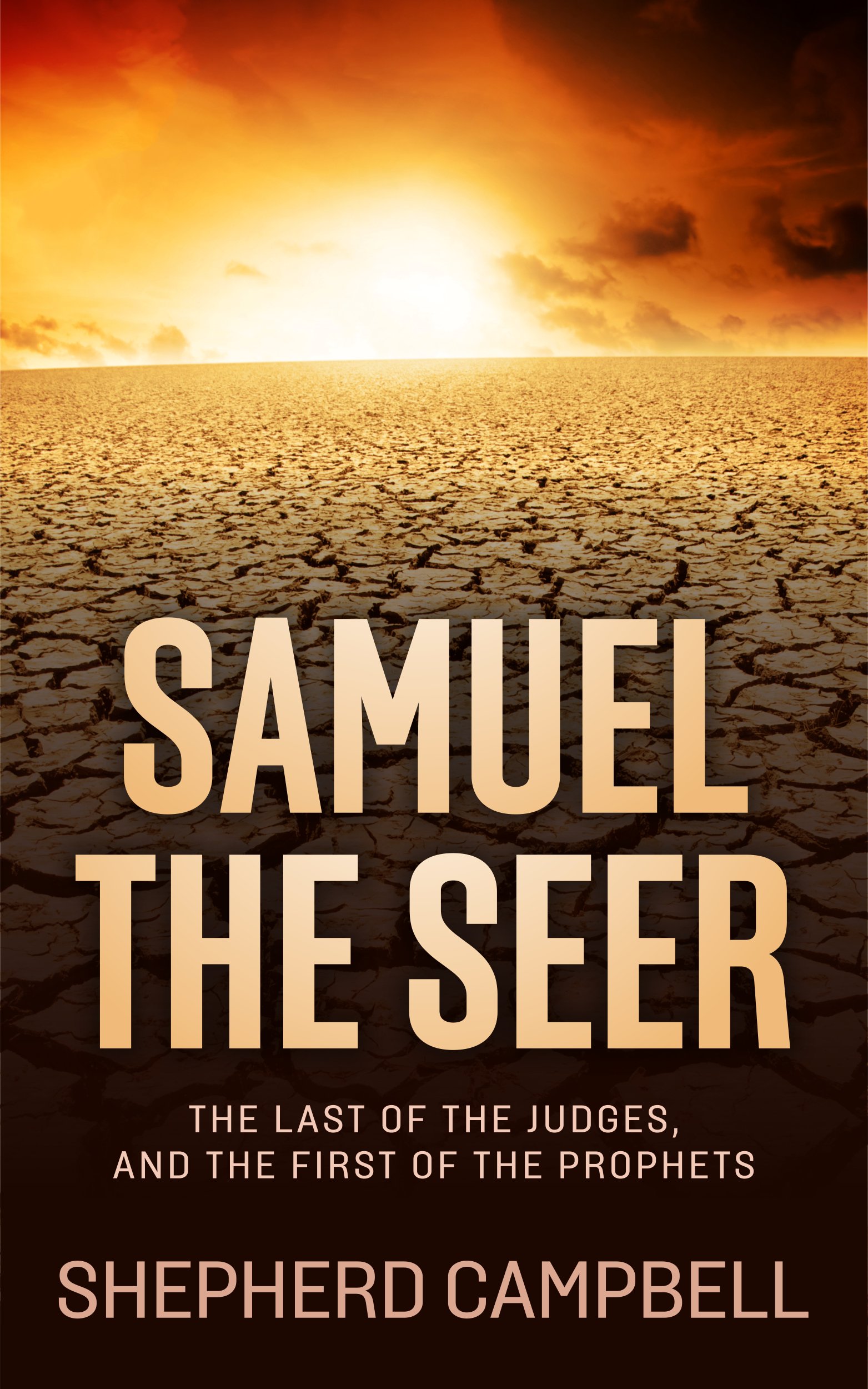VISIT OUR FACEBOOK PAGE!
The Royal Tribe of Judah
The Blessings of the Tribe of Judah
Jacobs Blessing - Gen. 49:8-12
"Judah, your brothers will praise you; your hand will be on the neck of your enemies; your father's sons will bow down to you. You are a lion's cub, O Judah; you return from the prey, my son. Like a lion he crouches and lies down, like a lioness - who dares to rouse him? The scepter will not depart from Judah, nor the ruler's staff from between his feet, until he comes to whom it belongs and the obedience of the nations is his.
He will tether his donkey to a vine, his colt to the choicest branch; he will wash his garments in wine, his robes in the blood of grapes. His eyes will be darker than wine, his teeth whiter than milk."
Moses Blessing - Deut. 33:7
"And this he said about Judah: 'Hear, O Lord, the cry of Judah; bring him to his people. With his own hands he defends his cause. Oh, be his help against his foes."
The Tribe of Judah Page Contents
Click on a link below to jump to that section of this page.
Map of the Hill Country District
Map of the Southern Kingdom of Judah
Tribe of Judah Land Allotment
God's choice in the allotment for the tribe of Judah would play a significant role in the longevity shown by the Davidic Dynasty. The geography of Judah's allotment isolated the tribe, and later the southern kingdom, from its neighbors. The only vulnerable region lay to the north. To the east, south, and west Judah was protected by geographical barriers.
The Shephelah protected the tribe of Judah to the west. This region guarded the main arteries of traffic leading to important cities. Judah controlled this region at times, though never fully controlled the coastal region. The Judean Wilderness protected Judah from the south and east. This region was often home to castaways, bandits, thieves, outlaws, and runaways. Jesus Christ may have been tempted in this desolate region. This geographical isolation protected and enabled Judah to stave off would be conquerors, and allowed for the southern kingdom of Judah to outlast its northern counterpart by 135 years.
The tribe of Judah, along with the
tribe of Benjamin and Simeon constitute what is known as the Southern Tribes of Israel. Judah was
the dominant tribe in this alignment. Much of the region encompassed by
these tribes would later fall under the heading of The Kingdom of Judah,
as Judah became the royal tribe of Israel in the south.
The tribe of Judah was the only tribe of Israel whose inheritance was determined prior to the invasion and conquest of Canaan. Their land was determined by Moses, as a reward for the report Caleb brought back from spying out the land in Numbers 13 and the faith he displayed in Yahweh.
Scripture lists the spies representing each of the 12 tribes of Israel sent out by Moses. The tribe of Judah was represented by Caleb. Caleb was the son of Jephunneh, and was a Kenite. The Kenites were descendants of Moses' father-in-law, Jethro. Though Caleb was a Kenite, he was reckoned as a member of the tribe of Judah. Not only did he represent this tribe as a spy, but afterward Scripture tells us he "went up with the men of Judah to live among the people of the Desert of Judah" (Judges 1:16). The Kenites would later be absorbed by the tribe of Judah.
Caleb was the only spy which reported the Israelites should go up into Canaan and conquer the land promised them by God. The other eleven spies complained of the size of the people, and the cities, and displayed terror towards the Nephilim spotted living in the land. They were ready to turn back to Egypt. Caleb, however, remained firm in the face of opposition.
Caleb paved the way for the tribe of Judah as the prominent tribe of Israel. The Lord became angry with His people for their lack of faith, and addressed Moses as such in the Tent of Meeting after the assembly had met. Moses, once again, interceded for the people.
God, in Numbers 14:24, singles out Caleb for his report.
"But because my servant Caleb has a different spirit and follows me wholeheartedly, I will bring him into the land he went to, and his descendants will inherit it."
Thus God had determined the tribal allotment for the tribe of Judah, as a reward for the faithfulness of Caleb. God simply wants people that have faith in His power. Caleb was one of these, and the tribe of Judah was rewarded greatly for this act of faith.
Indeed, the tribe of Judah encompassed nearly one-third of the total land area west of the Jordan River. Their allotment was by far the largest portion granted any of the tribes of Israel. In all, the allotment of Judah spanned nearly 2,300 square miles. The town lists of Judah can be found in Joshua 15:20-32, and Joshua 19:1-9.
The borders of Judah remain a topic of debate. At times, towns listed in one tribal allotment overlap into the boundaries allotted to another tribe. Oftentimes certain cities allotted to one tribe, may find it under the influence of another tribe. Some lists omit or add cities not mentioned in other lists describing the same area. The political situation often determined such events, and thus boundaries may shift and change in response. It certainly appears, upon close inspection, that oftentimes Biblical passages concerning, not only the tribe of Judah, but other regions, areas, and "districts", appear conflicting and inconsistent. One must keep in mind the fluid nature of society produced by migration, war, displacement, natural catastrophe, and other such forces which cause populations to uproot.
One such example is Jericho . Jericho was listed as a city within the allotment of the tribe of Benjamin. The tribe of Benjamin fell within the jurisdiction of the Southern Kingdom of Judah. However, during the Divided Monarchy, Jericho was under the rule of the Northern Kingdom.
Another factor contributing to border conflicts rests in the simple fact many cities mentioned in these town lists have not been positively identified as of yet. Without having the complete picture of an area in question, it is difficult to ascertain for certain specific landmarks, towns, villages, or other descriptions given.
Certain discrepancies within the tribe of Judah can be found by comparing the description of the borders of the land of Canaan, as given in Numbers 34, to that of the tribe of Judah given in Joshua 15. Scholars debate the northern, eastern, and western borders allotted to the tribe of Judah, as they differ in the two lists to some extent.
However, the southern border of the land of Canaan given in Numbers 34:3-5, and that given of the tribe of Judah in Joshua 15:2-4 are identical. This is no doubt greatly due to the influence of King David and the fact he conquered much of the southern region during his reign.
One topic of debate among scholars is the division of the cities within the tribe of Judah. Certain scholars claim town lists represent "sub-districts" within certain larger districts, all governed by the kingdom of Judah. The Bible makes no such distinction of these supposed sub districts. However, the Bible does divide the land of Judah into four large, geographical "districts" in Joshua 15:21-63.
These districts, in the order they appear in Scripture, are: the southernmost region of the Negev; the Western Foothills; the Hill Country; and the Judean Desert. Within each of these four regions lists of cities, towns and villages are given which constitute that particular area. It is in the southern Negev region where the Bible is identical in the description of the tribe of Judah and Canaan's southern border.
The Negev
"the southernmost towns of the tribe of Judah in the Negev"
Nadav Na'aman pointed out in his essay The Shihor of Egypt and Shur That is before Egypt that oftentimes Biblical boundaries seem strange to the modern observer. However, Na'aman further states modern day readers must keep in mind the ancients visualized geographical regions and areas "in terms of roads, settlements and directions".
Desert trails, bedouin paths, and landmarks, long since vanished, were often used to describe what would have been well known to the reader of that time.
The southern border of the tribe of Judah is given in Joshua 15:2-4.
"Their southern boundary started from the bay at the southern end of the Salt Sea, crossed south of Scorpion Pass, continued on to Zin and went over to the south of Kadesh Barnea. Then it ran past Hezron up to Addar and curved around to Karka. It then passed along to Azmon and joined the Wadi of Egypt, ending at the sea. This is their southern boundary."
The same area is described in near identical language by God to Moses years earlier, as recorded in Numbers 34:3-5. This passage dealt with the land of Canaan as a whole, thus, the southern border of the tribe of Judah is shown to be the same as the southern border of the land of Canaan as determined by God.
"Your southern side will include some of the Desert of Zin along the border of Edom. On the east, your southern border will start from the end of the Salt Sea, cross south of Scorpion Pass, continue on to Zin and go south of Kadesh Barnea. Then it will go to Hazar Addar and over to Azmon, where it will turn, join the Wadi of Egypt and end at the Sea."
The area described in these two passages include what is known as the Negev region. The Negev was the setting for many of the passages regarding the early travels and adventures of the Patriarchs, from Abraham to Jacob. This area was known for its pastureland, situated between the hills and desert.
The Negev received adequate rainfall for the grazing of flocks, however, not enough rainfall to support agriculture. Thus, one can grasp the early emphasis placed in the narratives of Abraham and the Patriarchs on obtaining water, and protecting wells. Water wells have been discovered scattered along the major wadis of the area. The later development of cisterns allowed for larger, and more permanent, settlements.
The Negev bordered Edom. The Edomites were descendants of Esau. Edomites and Israelites of the Negev often came into conflict over trade routes bordering the two countries. The Arabah was a hotly contested area between the two people. Important routes traversed this area, buffering the Negev and Edom.
It is interesting the coastal strip of Philistia is included in these descriptions. Though Caleb drove out the sons of Anak, and David subdued the Philistines, they were never completely wiped out. Thus, the area of the coastal strip was never fully annexed by Israel.
Land such as this was described as "the land that remains" in Joshua 13:2-3. Scripture makes it clear in the opening verses of this chapter that Joshua was "old and well advanced in years". This tells us the Israelites had been in Canaan for some time now, at least forty years we learn from Caleb later in Joshua 14.
Philistine rulers in Gaza, Ashdod, Ashkelon, Gath and Ekron, as well as the region from "Arah of the Sidonians as far as Aphek, the region of the Amorites", as well as other land remained outside of Israelite control.
The
significance of this rests in the fact God had instructed Moses as to
the southern border of Canaan, and up to this point in time Israel had
yet to conquer it. Gath, at one point, was a vassal state under king
Saul. It's history afterward is not clear.
The town list of the Negev is found in Joshua 15:21-32. One notices an inconsistency with the number of towns mentioned, and the number of towns said in the passage.
"The southernmost towns of the tribe of Judah in the Negev toward the boundary of Edom were: Kabzeel, Eder (Arad), Jagur, Kinah, Dimonah, Adadah, Kedesh, Hazor, Ithnan, Ziph, Telem, Bealoth, Hazor Hadattah, Kerioth Heron (that is Hazor), Amam, Shema, Moladah, Hazar Gaddah, Heshmon, Beth Pelet, Hazar Shual, Beersheba, Biziothiah, Baalah, Iim, Ezeth, Eltolad, Kesil, Hormah, Ziklag, Madmannah, Sansannah, Lebaoth, Shilhim, Ain and Rimmon - a total of twenty-nine towns and their villages."
One notices Scripture indicates twenty-nine towns allotted. However, thirty-six towns are actually listed. Another town list of Judah can be found in Joshua 19. After the conquest of the land of Canaan, Moses had to allot land to the remaining tribes. Joshua 19 records the city list of the tribe of Simeon. This list is very similar to the list in Joshua 15 due to the fact the allotment for the tribe of Simeon was taken from Judah's already allotted territory.
Joshua 19:9 sheds light on the reason why Simeon was given land from Judah.
"The inheritance of the Simeonites was taken from the share of Judah, because Judah's portion was more than they needed. So the Simeonites received their inheritance within the territory of Judah."
Na'aman argued the two lists derive from an earlier source, listing all of the cities as a whole within the borders of the kingdom of Judah. The two lists differ in the listing of Ether and Ashan. The absence of these cities from the Joshua 15 list indicate this list was composed at a later date than the one found in Joshua 19.
Ether and Ashan were wiped out by Sennacherib around 700 B.C. Their presence in the Joshua 19 passage indicates this is the later passage. Perhaps, the "twenty-nine cities" were from the original document, and for reasons unknown, more cities were occupied at the date of the composition of the current list. This, of course, is pure speculation.
The Western Foothills
The next geographic district mentioned in Scripture is the Western Foothills.
Judah was allotted the southern portion of the Western Highlands, and vital routes traversed this region, thus falling under the tribe of Judah's control.
This region was at the front of the battle with the Philistines waged throughout Scripture. II Chronicles 11:5-10 lists fifteen cities that were fortified under the reign of Rehoboam. Though the date of Rehoboam's reign as the time of these fortifications is in doubt, the cities mentioned in the list, and the fact they were fortified, are largely agreed upon.
The significance is these cities are located in the Western Foothills and Hill Country of the tribe of Judah. Na'aman points out the kingdom of Judah "dominated the western offshoots of Naphal Sorek". The Sorek Brook ran from the Great Sea, east, through the Western Foothills.
A glance at the map will show many cities popped up along the banks of this vital water source. Judah's influence was especially felt in the towns of Beth-shemesh, Zorah, and Eshtaol. The Philistine territory, however, also extended along the Sorek Brook, up to Timnah and Gibbethon.
The mention of Gath as a fortified city in this list has proven problematic. If the Gath mentioned is meant to be the Gath of Philistia, it is unlikely Rehoboam would have been able to take and fortify this Philsitine stronghold.
At the time of Rehoboam, Pharaoh Shishak was also waging war in the land of Canaan. Shishak exercised a dominion over Philisita as well, so it is improbable Rehoboam would have been able to fortify Gath. Other scholars have presented evidence of another Biblical Gath, one not under Philistine or Egyptian rule. This, however, is highly debatable.
It should be noted, however, as stated above Gath was an Israelite vassal under the reign of Saul. However, in the days of Uzziah it was a Philistine city. The remaining history of Gath is cloudy. Gath seems to have remained under Philistine occupation during the First Temple Period.
The Canaanite hero Goliath hailed from Gath. In fact, many of David's exploits took place in the Western Foothills, such as his showdown with Goliath. The Israelites and Philistine were encamped across from each other in the Valley of Elah. Scripture relates the Philistine were gathered for war at Socoth, and encamped nearby at Ephes Dammim.
Ephes Dammim was between Socoth and Azekah, near an intersection where two roads diverged. Saul and his men more than likely had traveled from the east, whereas the Philistines had traveled from nearby Gath and Ekron. As Saul had arrived to set camp, so the Philistines had as well, arriving from Gath.
The two armies faced each other from across the Valley.
"The Philistines occupied one hill and the Israelites another, with the valley between them." I Sam. 17:3
From the Philistine side of the valley "a champion named Goliath, who was from Gath, came out of the Philistine camp. He was over nine feet tall". It was here, in the Valley of Elah, in the western foothills of the tribe of Judah, one of its member would emerge from the Israelite camp.
"Then he took his staff in his hand, chose five smooth stones from the stream, put these in the pouch of his shepherd's bag and, with his sling in his hand, approached the Philistine." I Sam. 17:40
David stepped forward to face Goliath, and began his journey to become king of the tribe of Judah, and of all Israel. This was just one of many remarkable and mysterious events which transpired in these western foothills of Judah.
As David emerged a hero, the tribe of Judah witnessed the first of many acts of its future king. In each instance, the odds seem to be greatly stacked against the men of Judah. Gath produced its share of warriors as well, as recorded in one instance (of many) in I Chronicles 20:6-7.
"In still another battle, which took place at Gath, there was a huge man with six fingers on each hand and six toes on each foot - twenty-four in all. He also was descended from Rapha. When he taunted Israel, Jonathan son of Shimea, David's brother, killed him."
God empowered the tribe of Judah to wage war against physical giants, descendants of the Nephilim. The implications of these passages are staggering. It is quite likely these Nephilim descendants had lost much of the "supernatural" abilities of their predecessors. However, Scripture plainly indicates they were far superior in size, and seemingly anchored in at Gath.
These tiny Jews, under the leadership of David, slaughtered men the size of which we cannot imagine. The tribe of Judah was at the forefront of these battles, and the Western Foothills were the front lines of this war. Hebron and Gath were early Anakim and Philistine strongholds, both possessing deep Nephilim connections.
Caleb drove out the Anakim from Hebron, as discussed previously. David continued the efforts by waging war against the Philistines. The town list of the Western Foothills is found in Joshua 15:33-47.
"In the western foothills: Eshtaol, Zorah, Ashnah, Zanoah, En Gannim, Tappuah, Enam, Jarmuth, Adullam, Socoh, Azekah, Shaaraim, Adithaim and Gederah - fourteen towns and their villages. Zenan, Hadashah, Migdal Gad, Dilean, Mizpah, Joktheel, Lachish, Boxkath, Eglon, Cabbon, Lahmaas, Kitlish, Gederoth, Beth Dagon, Naamah and Makkedah - sixteen towns and their villages. Libnah, Ether, Ashan, Iphtah, Ashnah, Nezib, Keilah, Aczib and Mareshah - nine towns and their villages. Ekron, with its surrounding settlement and villages; west of Ekron; all that were in the vicinity of Ashdod, together with their villages; Ashdod, its surround settlements and villages; Gaza, its surrounding settlements and villages, as far as the Wadi of Egypt and the coastline of the Great Sea."
The tribe of Judah never fully realized the fulfillment of these border descriptions. They never controlled fully the coastal region, and never completely annexed Philistine territory. As is the case today, boundary disputes and land led to countless bloody conflicts between these ancient enemies.
However, it was from the valleys of the western foothills the tribe of Judah would produce a king. David's encounter with Goliath triggered a sequence of events culminating in the establishment of the Davidic Dynasty.
The Hill Country of Judah
The tribe of Judah also inherited the vital central hill country of Canaan. This area would become the heartland of the Judah, especially during the reign of the southern kingdom. The hill country rested on an elevated plateau, ranging in altitude from 2,000 to 4, 000 feet.
The hill country extends from Hebron in the south, the higher elevated area, towards Jerusalem in the north. Jerusalem, however, was allotted to the tribe of Benjamin. The two tribes share many similar cities within their allotment, particularly in the area surrounding Jericho and Jerusalem (both of Benjamin).
The Central Ridge Route led straight through the heart of the tribe of Judah. This ancient roadway was a vital route through Canaan. Indeed, today this ancient route remains one of the major highways in the area. Important cities such as Hebron, Beth-zur, Jerusalem, and Gibeah were located on, or just off, the Central Ridge route.
This route ran across the crest of the mountains extending northward in this region. These central highlands were vital to the security of Israel. The towns and villages of the tribe of Judah were typically perched atop hilltops, or on rocky slopes.
The soil in this region was exceedingly rich and fertile. The land was ideal for crops and grazing, and the men of Judah took full advantage of the land's provision. Crops such as wine, oil, corn and fruit grew in abundance. Courageous Jewish Shepherds would venture their flocks to far-flung neighboring plains.
Though this area was the most abundant within the tribe of Judah, it was also the most vulnerable and exposed. Geography enclosed Judah from the south, east, and west. The northern front, however, remained readily accessible by the Central Ridge Route, as well as other routes linking the south to the northernmost limits near Lebanon.
Jerusalem was the major northern city of the tribe of Judah. It would become the capital city of the southern kingdom, established by David as such, taking it from the Jebusites. Though allotted to Benjamin, they had failed to drive out the Jebusites occupying Jebus, or ancient Jerusalem. The opening chapter of Judges depicts "the men of Judah" capturing Jerusalem. Jerusalem exchanged hands frequently even in the city's earliest stages of existence.
Jerusalem saw drastic growth and expansion in the seventh and eighth centuries. At its height, it was many times larger than any other city within the southern tribes. Metropolitan Jerusalem, and its surrounding towns, villages, and agricultural areas, would have encompassed much land from within both the tribe of Judah and the tribe of Benjamin.
Kearith-jearim is another city which shows both prominence within the tribe of Judah and Benjamin. This city is mentioned within the tribe of Judah in Joshua 15. However, in Joshua 18 it appears in the list of the tribe of Benjamin.
During the reign of the southern kingdom, Kiriath-jearim was a main outpost of sorts in the north. Na'aman states the city formed a "ramified network of connections with neighboring towns". Eventually the city lost its significance, and became considered once again a Benjamite city.
Joshua 15:48-60 gives the town list of the hill country.
"In the hill country: Shamir, Jattir, Socoh, Dannah, Kiriath Sannah (that is Debir), Anab, Eshtemoth, Anim, Goshen, Holon and Biloh - eleven towns and their villages. Arab, Dumah, Esahn, Janim, Beth Tappuah, Aphekah, Humtah, Kiriath Arba (that is, Hebron) and Zior - nine towns and their villages. Maon, Carmel, Ziph, Juttah, Jezreel, Jokdeam, Xanoah, Kain, Gibeah and Timnah - ten towns and their villages. Halhul, Beth Zur, Gedor, Maarath, Beth Anoth and Eltekon - six towns and their villages. Kiriath Baal (that is, Kiriath Jearim) and Rabbah - two towns and their villages."
In all, thirty-eight towns are listed in the hill country. The list starts in the south, with Jattir, and works its way north to Kiriath-jearim. Jattir borders the northern limits of the tribe of Simeon's allotment.
The Desert of Judah
The last geographical district within the tribe of Judah was the Judean Desert, also known as the Judean Wilderness. This region lay to the southeast of Jerusalem, bordering the entire western banks of the Dead Sea. The Wilderness of Judah was a dry, desolate area, only ten miles in width.
This stretch of wilderness provided a formidable barrier protecting Judah from the south and east. The mountains in this area plummeted abruptly more than 3,500 feet from Jerusalem to Jericho. A few settlements populated this area, mainly settling near the watershed. Sparse vegetation provided minimal grazing for sheep and goats.
The Judean Wilderness served primarily as a hideout for thieves, criminals on the run, outlaws, outcasts, brigands, and such. However, the region was home to plenty of leopards, bears, and wild goats. The monastic settlement at Qumran, site of the Dead Sea Scrolls, was located in this region. Numerous caves can be found throughout the mountainous cliffs of this region.
The abundance of these caves, coupled with the lack of settlement, made this area attractive for those seeking refuge from mainstream society. The Dead Sea Scrolls were found in jars stored in these caves. Scholars feel these caves may have been a refuge for those fleeing the Romans during the First and Second Revolt. This area may have been the last stronghold of those resisting the Romans during the Second Jewish Revolt. This Revolt ultimately led to the destruction of the Second Temple by the Romans around 70 A.D.
The cities given in this region are listed along a north-south longitudinal axis. The northernmost city listed starts with Beth-arabah, just south of Jericho, and ends with En-gedi in the south.
The desert
region is divided into three "districts", or, geo-regions; the
wilderness of En-gedi in the south, the wilderness of Judah, and the
wilderness of Maon, located between the Hebron mountain range and the
Dead Sea.
The town list is given in Joshua 15:61-63.
"In the desert: Beth Arabah, Middin, Secacah, Nibshan, the City of Salt and En Gedi - six towns and their villages. Judah could not dislodge the Jebusites, who were living in Jerusalem; to this day the Jebusites live there with the people of Judah."
Interestingly enough, though Jerusalem is mentioned nowhere in any of the town lists for the tribe of Judah, Scripture portrays them battling with the Jebusites in an attempt to gain Jerusalem. Jerusalem, or Jebus as it was known by the Jebusites, fell within Benjamin's allotment.
Based on this information, it would seem logical the men of Judah allied with the men of Benjamin in an attempt to drive out the Jebusites. This was a common occurrence amongst the tribes during their conquest of Canaan. Though a full scale alliance was never made, certain tribes would join forces to drive out common enemies, and to conquer certain areas.
These areas, like Jerusalem, would have been near the border of two tribes. It would not be until the time of David Jerusalem would become Israel's capital. It is obvious the tribe of Judah, thus, played a central role in the development of Jerusalem as the Israelite capital. Indeed it seems Jerusalem was more or less absorbed (though not according to the official Biblical record) into the stronger tribe of Judah.
The Tribe of Judah Encampment
The encampment of the Israelite tribes in the wilderness was meticulously planned and organized by God. He gave Moses very strict and specific instructions as to where each tribe was to camp in relation to the Tent of Meeting, and when each tribe was to break camp. These orders are given in Numbers 2:3-4.
"On the east side, towards the sunrise, the divisions of the camp of Judah are to encamp under their standard. The leader of the people of Judah is Nahshon son of Amminadab. His division numbers 74,600."
Their marching order is given in Numbers 2:9.
"All the men assigned to the camp of Judah, according to their divisions, numbered 186,400. They will set out first."
The tribe of Judah was the head of their division. This division included the tribes of Zebulun and Issachar as well. Judah encamped on the east side of the Tent of Meeting. The entrance to the Tent of Meeting was also located on the east side of the Tent, facing the rising sun. Moses and Aaron also camped on the east side.
However, Moses and Aaron were within the tabernacle compound itself, whereas the tribe of Judah was outside the courtyard. The east side of the Tent of Meeting, by implication, thus was the favored side, where God encamped those favored tribes and elevated individuals.
AS the tribes of Israel broke camp, the division under the leadership of Judah would be the first to break camp. The tribe of Judah, followed by the tribe of Zebulun and Issachar, would lead the march through the wilderness. In military terms, they were on point.
Judah
Judah was the fourth born son of Jacob and Leah. He would be the last child Leah would produce for Jacob. His birth is recorded in Genesis 30:35.
"She conceived again, and when she gave birth to a son she said, 'This time I will praise the Lord.' So she named him Judah. Then she stopped having children."
The name Judah translates as "Praise". It would seem that the first four sons of Jacob were born in rapid succession. Though Scripture does not indicate this outright, the chronology of Scripture lists these four sons being born in consecutive verses.
Judah's first appearance in Scripture occurs in the story of Joseph. In Genesis 37:26 Judah is seen in discussion with his brothers as to what they should do with Joseph. Judah's guilt is seen in his willingness to go along with his brothers in their mistreatment of Joseph.
However, Judah does redeem himself somewhat in the narrative by convincing his brothers not to kill Joseph. He argues they should sell him into slavery.
"Judah said to his brothers, 'What will we gain if we kill our brother and cover up his blood. Come, let's sell him to the Ishmaelites and not lay our hands on him; after all, he is our brother, our own flesh and blood.' His brothers agreed."
Judah, thus, spared the life of Joseph. However, Scripture clearly indicates Judah was not the man God wanted him to be as of yet. The very next chapter in Scripture deals with Judah and Tamar. The placement of this narrative in the Bible is strange. It abruptly interrupts the Joseph narrative.
Perhaps the author's intent was to show that while Joseph was living his life in Egypt, his brothers were carrying on business as usual back home with Jacob. Also, this episode involving Judah and Tamar seems to have played a significant role in the spiritual development and maturation of Judah.
He shows a great amount of character and humility at the end of this story. God was using these events to shape and mold Judah into the man that would be the progenitor of the most successful line of kings in the history of Israel.
Judah and Tamar - Gen. 38
After the sell of Joseph, Scripture indicates Judah moved from his brothers, and lived with a friend, "a man of Adullam named Hirah". Adullam was approximately 8 miles northwest of Mamre as the crow flies. Jacob and sons had settled in Mamre following the death of Isaac. The Bible does not give a reason for Judah's move, however, it would not be presumptuous to assume he was distraught over what he had done to Joseph.
Perhaps it was too much to dwell amongst his brothers after such an ordeal. Judah, maybe, needed time away to sort through the ramifications of what he had done. Perhaps his spirit became broken, and he needed time away and with God. Interestingly, very little is said of his friend Hiran. Hiran, however, plays a prominent role in this narrative.
In Adullam, Judah falls in love with a Canaanite woman, the daughter of a Canaanite man named Shua. This is an indication Judah was still not wholeheartedly following after God. Scripture is very clear concerning the marital status of His people. They were not to intermarry with Canaanites. Judah, clearly not in conjunction with the wishes of God, married this woman, and they produced children.
Though Scripture is silent regarding the identity of Judah's wife, and mentions nothing of her character or personality, through the actions of their children it is safe to assume she was not a godly woman. The first born son of Judah and this Canaanite was named Er.
Er's appearance in the Bible is brief. Scripture records his birth, and that of his two brothers, Onan and Shelah, in the opening verses of Genesis 38. In verse 6 Judah is seen obtaining a wife for Er. This woman's name is Tamar, the central figure in this narrative. Er's appearance, however, is brief, for in verse 7 Scripture relates he is killed.
"But Er, Judah's firstborn, was wicked in the Lord's sight; so the Lord put him to death."
Nothing further is said concerning Er's grievous actions. As was the custom of the day, if a son died while married, it was the duty of the surviving brother to marry their dead brother's wife, and to have children in the dead brother's name. A widowed woman was in dire straits in this male dominated society. The death of her husband would leave her vulnerable, and without means, or any way of obtaining means to live.
Judah instructs Onan to "fulfill your duty to her as a brother-in-law".
Onan married Tamar, though it becomes evident this was done against his
wishes. Onan was to provide Tamar with a child. This child would be
recognized as a son of Er. Onan did not wish to produce a son that would
not be reckoned as his.
"But Onan knew that the offspring would not be his; so whenever he lay with his brother's wife, he spilled his semen on the ground to keep from producing offspring for his brother."
This willful act of rebellion was noticed by God.
"What he did was wicked in the Lord's sight; so he put him to death also."
The tribe of Judah was off to a rocky start no doubt. Judah was having much trouble finding a heir to carry on his name, and to establish the tribe of Judah. God kept putting his sons' to death due to their wickedness. Judah, perhaps, by this time began to realize the error of his ways.
It would seem his sons were keeping in line with their mother's Canaanite religious practices. Though the Bible does not outright state this, it would seem logical due to God's judgment upon Er and Onan they were not aligned with Yahweh, and the faith of Jacob and the Patriarchs.
At this point in the story, Judah tells Tamar to return to her father's house, and "live as a widow". The understanding is his youngest son, Shelah, will marry Tamar once he grows up. Scripture implies, however, Judah had no intentions of giving his youngest son to Tamar.
"...For he thought, 'He may die too, just like his brothers..." Gen. 38:11.
As a result of this thinking, Judah violates the trust Tamar had placed in him, and shows a selfish side of his personality. Not only was he being selfish, but he was damning Tamar to live as a widow. The life of a widow was destined to be one of poverty, unless a woman resorted to prostitution in order to make a living.
Tamar, however, caught wind of Judah going to Timnah to check on his sheep. Hirah, Judah's friend, accompanied him on his trip to Timnah. Though the Bible does not give how many years had passed since Tamar left Judah's house, it would seem quite some time had transpired. Verse 14 implies such.
"She took off her widow's clothes, covered herself with a veil to disguise herself, and then sat down at the entrance to Enaim, which is on the road to Timnah. For she saw that, though Shelah had now grown up, she had not been given to him as his wife."
Judah had completely disregarded Tamar, and willfully and knowingly kept his son Shelah from her. He was admittedly in fear of his son's life. Tamar, though, would not be silenced so easily. She covered her face, to prevent Judah from recognizing her, and posed as a temple prostitute alongside the road.
She placed herself in a strategic location, where she was sure Judah would pass by. Scripture again indicates the state of Judah's heart, for upon seeing her, he immediately approached her, thinking Tamar a prostitute.
"When Judah saw her, he thought she was a prostitute, for she had covered her face. Not realizing that she was his daughter-in-law, he went over to her by the roadside and said, 'Come now, let me sleep with you."
As payment, Judah promised a young goat from the flock, which he will bring her later. Tamar demanded some collateral for her to hold onto in the meantime. Strangely enough, Judah did not hesitate to give her his seal, the cord by which the seal is attached to him, and his staff. Judah gave up his very forms of identification in order to sleep with a strange prostitute.
Unbeknownst to him, Judah sleeps with his daughter-in-law, then goes back to the business of his flocks. He later sent Hirah with the young goat to find the prostitute, and make the payment in order to regain his identification. Hirah, however, is unable to find the woman. He inquired of local men about the whereabouts of the temple prostitute, only to be informed no such prostitute dwelt in those parts.
Judah, upon hearing Hirah's report, realized he had been taken. He tells Hirah to let her keep them, "or we will become a laughingstock". Judah, seemingly, went back to business as usual.
Scripture indicates in verse 24 three months had passes since his encounter with Tamar. News reached Judah she had become pregnant, at which point he became irate.
"Judah said, 'Bring her out and have her burned to death!"
This indeed was a great offense to Judah's name. However, it was a situation he had created himself, and somewhere along the way lost touch with that fact. Judah exhibits a sense of self-righteousness here. His outrage at Tamar was a result of the situation he had created. His desire to sleep with a prostitute would seem to indicate he was not concerned with Tamar in the least bit. He was not following in the ways of God, as his father Jacob had.
Judah ordered the retrieval of Tamar immediately. Scripture relates Tamar sent a messenger ahead, with the seal, cord, and staff of Judah's.
"As she was being brought out, she sent a message to her father-in-law. 'I am pregnant by the man who owns these'."
Upon sight of his identification, Judah must have felt as if punched in the stomach by. It is in this one instance that follows, Scripture seems to suggest Judah became the man God wanted him to be. His immediate response, in verse 26, is indicative of a righteous and godly man.
"Judah recognized them and said, 'She is more righteous than I, since I wouldn't give her to my own son Shelah.' And he did not sleep with her again."
One notices the great men of God in the Old Testament were quick to acknowledge their wrongs, when confronted with them, and bow to God in reverence and repentance. Judah does just this. He immediately sees the whole picture as his fault. He understands why Tamar did what she did, and blames only himself.
God blessed Judah because of this attitude. The tribe of Judah would become the most exalted of all the 12 tribes of Israel. Judah would be blessed, through Tamar, by twin sons, Pharez and Zerah. Pharez would become an ancestor of David and Jesus Christ. Numbers 26:20 indicates Shelah became a clan within the tribe of Judah.
Tamar's actions in this narrative seem justified in light of the situation. Indeed, not one harsh word is spoken of her throughout the whole of the story. She is blessed by God with twin boys, one in the line of David. Tamar's status is even more exalted in the New Testament.
She is only one of the few women mentioned in the genealogical list of Jesus Christ in Matthew 1:3. Ruth, Rahab, and Bathsheba are the other women mentioned alongside Tamar. Each of these women, interestingly enough, were Canaanite women. Tamar posed as a prostitute, Rahab was a harlot, Ruth spent the night with Boaz as he lay drunk on the floor, and Bathsheba committed adultery with David.
Yet, these women were unquestionably strong believers in God. Their association in the very line of Jesus Christ testifies to the ability of God to overcome the weaknesses and mishaps of mankind. Tamar and Judah would lie the foundation for the kingly tribe of Judah through the birth of their twin sons.
The Tribe of Judah
From the above narrative it is plain the beginnings of the tribe of Judah were indeed dubious beginnings. However, it also becomes plain from the blessings of both Jacob and Moses the tribe of Judah was to play an integral role in shaping the history of Israel. God had a special purpose in mind for this tribe.
The exploits of the tribe of Judah are far too numerous to cover in full detail in such a short exercise. However, a general guide to its rise and prominence reveals quite a lot about Judah. In fact, until recently, evidence of the greatest of all of Judah's kings, king David, was not in existence. The lack of evidence led many to question the legitimacy of the claims made by the ancient scribes concerning the tribe of Judah.
However, an excavation site centered at Tel Dan, in northern Galilee, uncovered an inscription in 1993 which was conclusively dated to the ninth century B.C. The inscription tells how king Hazael of Arm, Damascus subjugated both the northern king of Israel Ahaziah, and king Jehoram "of the House of David".
The inscription dated to just a few generations after the death of David. The proximity of an artifact so close to the source was a remarkable discovery. This is the only reference in existence proving the tribe of Judah is right in claiming David was the originator of the Davidic Dynasty. This also legitimizes Jesus Christ's claim in the New Testament.
Critics, as they typically will, sought to punch holes immediately in the find. Some claimed this may have referred to another David, rather than King David. Others based arguments on linguistic grounds. In the Hebrew language no vowels are used. Using the three letter Hebrew spelling of the name, "David" translates as "Dod". Dod, in Hebrew, means "uncle". Critics, thus, claimed this could read "the House of an Uncle".
Such arguments appear less than convincing. The tribe of Judah, thus, can at least be traced back to the ninth century B.C. with solid evidence. Prior to this, from the time of the conquest of the land under Joshua, until the coronation of David around 1050 B.C., the tribes of Israel maintained political autonomy.
They formed a loose confederation of tribes, at times joining forces with select tribes, at times waging war amongst themselves. The southern "coalition" was led by the tribe of Judah. This coalition would have included the tribes of Benjamin and Simeon.
This, however, does not mean quarrels did not arise within the southern tribes. Times were often turbulent and violent. Such was the case in the Levite and the Concubine found in Judges. The atrociousness of this act led eleven of the tribes to unite against the tribe of Benjamin. Judah would have played a key role in the alliance due to their proximity to Benjamin, and indeed may have led the allied forces.
The tribe of Benjamin was nearly wiped out by its brothers, with only 600 men surviving.
The first chapter of Judges depicts the tribe of Judah as a fierce and effective military tribe. God Himself thought so. After the death of Joshua, the Israelites were said to have asked the Lord;
"Who will be the first to go up and fight for us against the Canaanites?"
Without hesitation, in verse two; "The Lord answered, 'Judah is to go, I have given the land into their hands."
It was out of this tradition the military genius of David would be born. The fighting men of the tribe of Judah proceed to march against the Canaanites. Scripture records the men of Simeon went with them, perhaps the reason they were later allotted land from within the tribe of Judah. In the first battle Judah engaged in, Scripture relates "they struck down ten thousand men at Bezek".
Scripture seems to imply Caleb played a major role in this conquest, perhaps he led the men, as he had represented them as their spy years earlier. Though the tribe of Judah was extremely successful, they failed to take full possession of the land, as indicated in Judges 1:19.
"The Lord was with the men of Judah. They took possession of the hill country, but they were unable to drive the people from the plains, because they had iron chariots."
These people were primarily made up of the Philistines, who dominated the coastal strip northward past Gath. Thus from their earliest experiences in Canaan, the tribe of Judah was on the front line of battle against the mighty Philistines. These people would prove to be the fiercest of all Israel's enemies. Their strength is seen in this passage by Judah's inability to drive them out.
It was this Philistine threat which led the Israelites to urge Samuel to seek a king for them from the Lord. They felt the only way to put an end to this threat was to unite under one king. They forsook faith in God, and placed it in the hands of a man. This paved the way for the anointing of Saul.
The exploits of Saul and David thrust the tribe of Judah to the forefront of the tribes of Israel. David's military prowess, and his ability to manipulate and deceive, factored with the loyalty he drew from the men that followed him, led David to rise to prominence within the tribe of Judah, and succeed Saul as King of Israel.
With David's ascension to the throne, the Davidic Dynasty was established. The tribe of Judah had secured their place in the annals of Jewish history as the kingly tribe. The line of succession, proceeding from David, would last nearly five centuries. It was this remarkable stability which enabled the poorer, more rural south, to outlive the stronger, and more prosperous northern kingdom.
The southern kingdom's reign over all of the tribes would not last nearly as long, however. After the death of Solomon, the northern tribes rebelled over the heavy labor requirements Solomon had placed on them. Solomon's son, Rehoboam, foolishly listened to his advisers when approached by representatives from the northern tribes to lighten their load.
His harsh response triggered a rebellion which would split the United Monarchy, and usher in the era termed the Divided Monarchy. The Disruption, as scholars call this, left the tribe of Judah with only the allotments of Benjamin and Simeon. The northern kingdom included the remaining nine tribes.
Jerusalem, however, was retained, thus the royal capital was intact. Had Jerusalem fallen to the northern forces, it is unlikely the tribe of Judah would have continued as it did. It becomes clear the southern kingdom of Judah maintained the spirit of Yahweh's commandments more so than the northern Kingdom.
Many scholars claim the northern kingdom set up a cultic center of worship based on the name of God Elohim. They set up a mock temple in Dan, and expelled the Levites from the northern kingdom.
Rehoboam, the son of Solomon, accepted the Levites from the north, setting them up as High Priests. II Chronicles 10 & 11 chronicle these sequence of events. The tribe of Judah, thus, became the tribe which would most closely adhere to the commandments and teachings of God.
Judah, though, was far from a perfect kingdom. Rehoboam clung to pro-Canaanite policies, and tolerated the religion. It would not be until Asa, who came to power around 908 B.C., that the Canaanite idolatrous practices were wiped from Jerusalem and Judah. Asa destroyed the idols, expelled the male prostitutes from the shrines, and demoted his grandmother, Maacah, who had taken the title as Great Lady and worshiped idols.
Asa was actually one of the few kings of Judah to earn praise from God. Asa's son, Jehoshaphat (868-847 B.C.) continued his father's pro-Yahweh policies. He instituted governmental reforms centered around a national judicial commission.
Later, king Josiah (639-609) would renew the covenant of Yahweh before the people of the southern kingdom. One of his priests discovered a scroll tucked away in the Temple archives. Hilkiah, the High Priest, reported to Josiah he had found "the Book of the Law".
The story is told in II Kings 22. Josiah read before the people from the Book of the Law in front of the Temple in Jerusalem. Scripture paints a beautiful picture of revival and renewal. Josiah was shocked to learn how far the people had strayed from the teachings of God to their forefathers.
Years earlier, under king Amaziah (801-773), the tribe of Judah and the southern kingdom suffered a disastrous defeat. Amaziah had brought back idols from Edom and worshiped them in Jerusalem. Joash of Israel attacked Judah, temporarily capturing Jerusalem and severely crippling the tribe of Judah.
Further evil was perpetrated by king Ahaz (741-725 B.C.). Upon returning from a trip to Assyria, he installed Assyrian gods in the Temple at Jerusalem. The Bible relates he also practiced human sacrifice, sacrificing a son of his own. This act was recorded in II Kings 16:3.
"He walked in the ways of the kings of Israel and even sacrificed his son in the fire, following the detestable ways of the nations the Lord had driven out before the Israelites."
Ahaz was crushed by Pekah of Israel and Rezin of Damascus for his refusal to join their coalition against the Assyrians under Tiglath-pileser III. Thus the southern kingdom of Judah experienced both righteous and wicked kings during its reign. The dynasty would last until the mid-sixth century B.C.
In 597 B.C., a rebellion started by king Jehoiakim was squashed. Jehoiakim's son, king Jehoiachin had inherited the rebellion. Nebuchadnezzar had sent Edomite, Ammonite, and Moabite forces to quell the rebellion. In 597, Jehoiachin surrendered to Nebuchadnezzar.
Jehoiachin's surrender is recorded in II Kings 24. Nebuchadnezzar looted the Temple treasure, took the king captive and back to Babylon, and is said to have deported 10,000 men from Judah.
Zedekiah, the uncle to the deposed king, was placed as king of the vassal, and much weakened, Judah. Zedekiah unwisely led a rebellion against Babylonian advancement, counting on Egyptian aid for success. The Egyptians, however, proved ineffective, and Judah fell once again to Babylon.
This time the consequences were fatal. Zedekiah was captured,
forced to watch his children murdered, blinded, then led in chains to
Babylon. More men were exiled from Judah to Babylon. The Temple and all
of Jerusalem was destroyed. This was the last of the tribe of Judah, and
the nation of Israel as a political state, until 1948.
The tribe of Judah produced some of the greatest figures in all of Jewish history. Any list of notable Judahites must start with Jesus Christ, the individual who impacted this world like no other before or since. Kings David and Solomon, as well as numerous others, descended from the ranks of the tribe of Judah.
Judah also maintains an impressive list of prophets. Amos and Habbakuk were two such prophets. Isaiah was an eighth century Judean prophet, and the author of the book of Isaiah. Jeremiah was a cousin of King Uzziah. Micah, Obadiah, and Zephaniah were also prophets from the tribe of Judah.
The promised Messiah will one day emerge from the tribe of Judah, and unite all of the world under God's rule. To the Christian, this Messiah has arrived already in the form of Jesus Christ. To the Jew, this Messiah is yet to come.
The Tribe of Judah was the royal tribe of Israel. King David & Solomon hailed from this tribe. Jesus, as a descendant of David, was from Judah as well. It is, indeed, the royal tribe of Israel.
Study Resource
Joseph Samuel Christian Frederick Frey was an American-Jewish author. Born in Germany, in 1773, he became one of the most influential writers of his time. In 1798 Frey converted from Judaism to Christianity. His work entitled, Judah and Israel: or, the Restoration and Conversion of the Jews and the Ten Tribes, first published in 1840, was a landmark achievement, and continues to provide valuable insight. Amazon.com has brought back this edition, making it available to the public. Click on the link below to visit Amazon.com!
Judah and Israel: or, the Restoration and Conversion of the Jews and the Ten Tribes
Back to the Tribe of Judah
Back to the 12 Tribes of Israel
Back to the Home Page
The Tribe of Judah - The Royal Tribe
King David and Jesus Christ are just two of the descendants from this tribe. Give your insights and opinions on Judah, the tribe from which the scepter shall not depart.
What Others Have Said
Click below to see contributions from other visitors to this page...
Words of Yashua 




I follow Yahshua who is the Lion of our Royal Tribe of Judah. The christian church is not teaching the very words that will save you, those are the Words …
A Lioness of Judah 




God is calling an army of believers to Zion. The scattered tribes are being called home. The Lord is sending out His prophets, of which I am one, to call …
Common Names Linked to the Tribe of Judah? 




I was also trying to trace my lineage, and was told that I may be of this tribe.
What are the origins of the name "Harris"?
Verifying My Lineage 




I am an American born Negro wanting to know how to find proof that I am tied through bloodline to The Tribe of Judah.
I would like to be able to explain …
True LION of the tribe of Judah Not rated yet
It is awesome to think how God has chosen the tribe of Judah. In my earlier readings of this portion of bible gave me much confusions and doubts, but God's …
Moses & Jethro Not rated yet
As has already been said, Joshua and Caleb both gave good reports of the land to be conquered.
I'm also not sure of the reference to Jethro, Moses' …
The Tribe of Judah Not rated yet
The 12 Tribes of Israel is related to the 12 Signs of the Zodiac, and is in harmony to their Birth. Example, Reuben is of the First Constellation Aries. …
Joshua and Caleb Were Faithful Spies Not rated yet
This article states that Caleb was the only spy who brought back a good report out of the twelve. Not sure if that is an error or misprint but, politely …
Geneaolgy of Jesus Not rated yet
This is great. For some reason, I overlooked that Jesus was from the tribe of Judah. I was thinking it came from Rebecca's son.
Praise be to God …
Hogan Not rated yet
Glory to God the Father, Son, and Holy Ghost. In years past, research such as this simply was not in my desires. I would chalk up such talk as militant. …
Recent Articles
-
The Tabernacle of Moses
Feb 19, 25 09:50 AM
The tabernacle of Moses was built by Moses, per instruction from God, during the Exodus out of Egypt. It represented God's presence amongst His people. -
The Ark of the Covenant
Feb 19, 25 09:46 AM
The Ark of the Covenant is one of the most mystifying objects in all of human history. It's power was so great that Israel often carried it to the front lines. -
King David of Israel
Feb 19, 25 12:51 AM
The story of King David of Israel is a rags-to-riches tale of the family runt rising to national King. King David would become Israel's greatest king.
SAMUEL the SEER
Now Available in Print & eBook on Amazon!!
POPULAR TOPICS
Learn more about these popular topics below. The Bible is full of fascinating stories, characters and mysteries!
BIBLE MAPS
Explore the land of the Old Testament! View these maps of the Bible.
